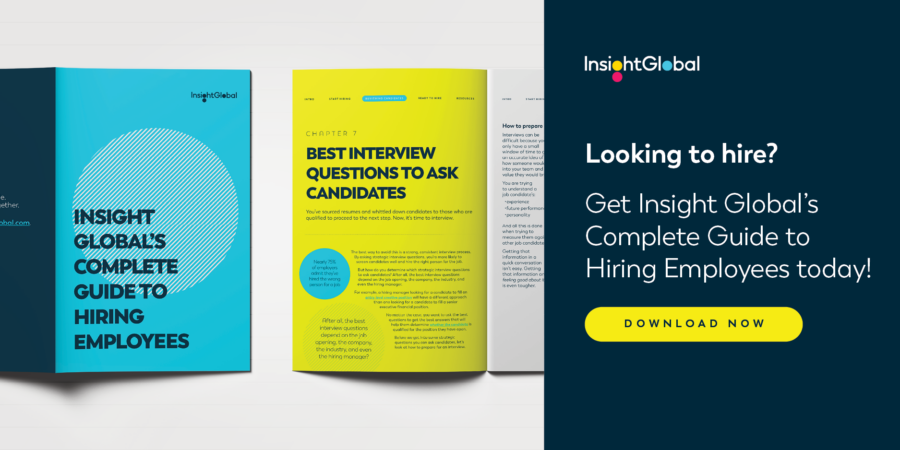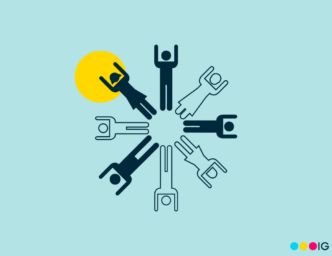Have you ever found yourself acting particularly friendly or welcoming to someone because you learned they went to the same school as you or were wearing the logo of your favorite sports team? This could be a result of affinity bias, which is the tendency to favor people with similar interests, experiences, and backgrounds.
Have you ever been surprised by the good qualities of someone you first mistrusted? That mistrust might have stemmed from an unconscious bias that negatively clouded your perception.
Unconscious bias is surprisingly sneaky. It can cause people to quickly accept or reject someone based on traits or affiliation, sometimes ignoring critical details.
A blind hiring process is designed to remove the cues that might trigger unconscious bias, so you can focus on the facts: is this person qualified, and do they have the skills they need to fulfill the position?
Blind hiring has the added benefit of fairly contributing toward diversity in a balanced way. This is important because studies show companies with a strong commitment to diversity, equity, inclusion, and belonging (DEIB) enjoy many benefits.
What is a Blind Hiring Process?
Companies that use a blind hiring process remove key personal information from all candidates’ applications. This is designed to eliminate the potential for unconscious bias during the hiring process. The goal is to find the most qualified candidate for the job and to secure top talent free from preconceived notions.
Statistics About Biases in Hiring
If you are like most people, you may think to yourself, “I don’t have any biases!” On the surface, it can seem unlikely that you will allow gender, race, or other factors to influence your hiring decisions. However, unconscious bias is more pervasive than many of us imagine.
A Yale study looked at gender bias in hiring by male and female scientists. The scientists received job applications, which were randomized to be from “John” or “Jennifer.” The scientists, regardless of gender, were more likely to hire male students, mentor male students, and pay male students a higher starting wage.
In a joint study done by the University of Chicago and the Massachusetts Institute of Technology, researchers sent nearly 5,000 resumes in response to more than 1,300 job ads. They randomly assigned “very white-sounding names (such as Emily Walsh or Greg Baker) to half the resumes and very African American-sounding names (such as Lakisha Washington or Jamal Jones) to the other half.”
The study found that the fictitious white applicants were 50 percent more likely to receive a callback than their African American counterparts.
Building upon this research and other studies, UC Berkeley and the University of Chicago submitted 83,000 job applications to Fortune 500 employers. Half of the applications had traditionally white-sounding names, while the other half had names designed to make the employer assume the applicant was Black. The applicants with Black-sounding names received a 10 percent lower response rate across the board.
Blind hiring helps eliminate those sneaky, unconscious factors that may result in suboptimal hiring choices.
Why Diversity Is Important in the Workplace
Studies show a long list of benefits to a diverse workplace. Here are a few:
- Diversity in the workplace leads to higher-quality work, better decision-making, and greater team satisfaction.
- According to a McKinsey study, “Companies in the top quartile for racial and ethnic diversity are 35 percent more likely to have financial returns above their respective national industry medians.”
- Diversity improves performance. Three out of four organizations with a diverse and inclusive culture reflected in their frontline decision-making teams exceed their financial targets.
How to Create a Blind Hiring Process
Taking a few extra steps during the hiring process can eliminate unconscious bias and ensure you are picking the most qualified candidate for the job.
Blind Resume Review
Multiple software solutions can help with blind hiring, including Vervoe, Blendoor, or Gapjumpers.
You can also create a blind resume review by giving all incoming resumes to a team member not involved in the hiring process. Using a template, they can anonymize each candidate’s information and assign them a number.
The template should include the following:
- Work experience
- Skills
- Degree
- Any other important position-specific information
In the first round, you don’t have to worry about soft skills since you’ll have a chance to examine each candidate more in-depth during the interview process.
Once you’ve anonymized the information, the hiring team can evaluate applicants on their experience and skills without any knowledge of factors that may lead to bias. The hiring team can use the essential information to select the top candidates they want to interview.
Blind Candidate Screening
A blind resume review is the first and easiest option for a blind candidate screening. Another popular screening process is a candidate skills assessment. These are easy to anonymize, and they test all applicants on an even playing field. Rather than just seeing a document with their work history and skills listed, you can see recent test results and compare scores across candidates.
Some job platforms, like Indeed or LinkedIn, include a selection of skills assessments. Vervoe and TestGorilla also offer a selection for employers.
Part of blind candidate screening is knowing what NOT to do. This early in the hiring process, don’t look at candidates’ social media information. Their social posts could introduce implicit bias.
Blind Interview
Not all companies who engage in blind hiring practices anonymize the interview. It’s much less common than blind screening. However, it’s impossible to eliminate biases when you are speaking to someone in person, over the phone, or through a video chat.
You can conduct a normal interview process after a blind candidate screening, and this should improve your hiring process by degrees. However, the best way to truly implement a blind hiring process is also to protect the interview process—or at least the first interview—from unconscious biases.
One blind interview technique is using an anonymized written questionnaire. Candidates can complete this on their own schedule. You can easily compare answers between candidates, without knowing any of their demographic information.
Alternatively, you can conduct an anonymous interview via chat. This is still scheduled like a normal interview, but it relies solely on written communication.
While speaking with candidates without knowledge of their gender, ethnicity, age, and other factors minimizes unconscious bias, it’s not a perfect method of evaluating candidates. Written communication does not contain the voice tonality, facial cues, and body language that are essential to fully understanding a person.
The Limitations of a Blind Hiring Process
While blind hiring can be an effective way to pull the focus away from factors like gender, ethnicity, and age so you can prioritize an applicant’s skills and experience, it has its limitations.
A Strict Blind Hiring Process Could Inaccurately Assess Candidates
Some critical information about a candidate can be lost during a blind hiring process. Here are three examples.
While employment gaps are less of a concern after the past several years, hiring managers usually want an explanation for them anyway. But a blind hiring process would remove identifying details like caring for young children or going on a multi-year religious mission trip. Without this context for an employment gap, a hiring manager can’t accurately assess a candidate.
Many positions require a candidate with good people skills. Employers can’t fully gauge a candidate’s personality without a phone, video, or in-person interview.
Finally, when the hiring process relies heavily on skills assessments, it may inadvertently eliminate some candidates unwilling or unable to find the extra time to complete skills assessments.
Blind Hiring Alone Doesn’t Improve DEIB in the Workplace
A blind hiring process only addresses the symptoms of bias, not the cause. Building a diverse workforce where all employees feel included—and all candidates feel welcomed—takes a genuine commitment to diversity, equity, inclusion, and belonging (DEIB).
If a company is actively looking to increase diversity, blind hiring alone may not result in more diverse candidates. Blind hiring only minimizes unconscious bias during candidate selection. It doesn’t change which candidates apply for the role. Diverse recruitment is needed too.
Finally, even after you do hire diverse employees, what are you doing to keep them? Do your new hires feel welcomed and included on their first day of work?
Best-selling author Austin Channing Brown, a Black woman, has written about her experiences in showing up to job interviews and other professional events where people expressed open surprise that she wasn’t a white man. Each time this happened, she felt like she didn’t belong there—regardless of her impressive credentials.
Your company may struggle to retain diverse employees if you don’t train leadership on the importance of DEIB in the workplace.
Tips to Add DEIB to Your Hiring Process
Even if you don’t implement a blind hiring process, you can still organically increase the inclusivity and diversity of your company.
Write an Inclusive Job Description
Some words and phrases trigger a job seeker’s unconscious bias. To attract a diverse population of job seekers, remove gender-coded or age-referencing language.
For example, some people interpret words as “feminine” or “masculine,” and they might hesitate to apply for a job that uses gender-coded language. Here are a few gender-coded words to avoid in an inclusive job description:
- Feminine-coded words: Support, agree, collaborate, interpersonal, trust, commit, understand, compassion, and share
- Masculine-coded words: Ambitious, aggressive, confident, fearless, decisive, assertive, independent, dominant, and driven
Some women may be less likely to apply unless they have all the listed skills and meet all the requirements, while many men are still likely to apply even if they don’t. To balance this tendency, separate the skills and requirements in your job description into must-have and nice-to-have.
You can always add that you are an Equal Opportunity Employer committed to creating a diverse and inclusive company culture.
We have a separate article on writing an inclusive job description if you want detailed advice.
Use Structured Interviews
In a structured interview, the interviewer asks each candidate the same questions in a standardized order. The interviewer collects the responses and grades them against a scoring system. This systematic approach helps more accurately compare responses from different candidates.
With a structured interview, the questions are formulated in advance to elicit the most essential and relevant information. The interview experience is consistent across different candidates, and it minimizes bias since the interviewer works from a standardized script.
Of course, you’ll still want to ask some questions specifically about a candidate’s experience, but try to ask mostly the same questions.
Diversify Your Hiring Staff
Unconscious bias is complex, as in the study mentioned above, where both male and female scientists chose more male candidates. However, a more diverse hiring staff can deliver several benefits.
Individuals with different backgrounds and genders bring additional insights and understanding to the hiring process. They recognize skills and potential in different ways.
When potential new hires meet a visibly diverse hiring team, they are more likely to recognize the company’s efforts toward diversity. They will feel welcome and see themselves fitting into the company culture.
Hiring managers are often the first leaders a new candidate meets, and they set the tone for expectations of the company’s culture.
Look for Culture Add
In some ways, a culture add is the opposite of blind hiring, but it serves the same big picture. Rather than ignoring all personal details during the hiring process, you may identify the top candidates and then make your hire based on what they add to the team that is not already there.
While unconscious bias leads toward sameness, a culture add looks for the qualified individual who brings something new to the mix. For example, your new hire may add a set of skills, a different personality, or a background yet to be represented in the department or company.
Diversity Increases Your Matrix of Talent
Diversity and inclusion in the workplace create a foundation for innovation, creativity, and performance. Many job seekers in today’s marketplace value inclusion, and increasing diversity makes more qualified and talented candidates feel welcomed, respected, and valued.
Blind hiring isn’t the only way to increase diversity, but it is essential to understand the power of unconscious bias in default hiring decisions and to consciously steer away from letting those biases rule.
If you would like to speak with our experienced team about increasing the diversity in your talent pool, we’re happy to help! Fill out the form below, and a member of our DEIB team will reach out soon.
Looking for DEIB Solutions?
Work with Insight Global to start building a diverse workforce.


 by Brita Long
by Brita Long 






 by Rie Parker
by Rie Parker